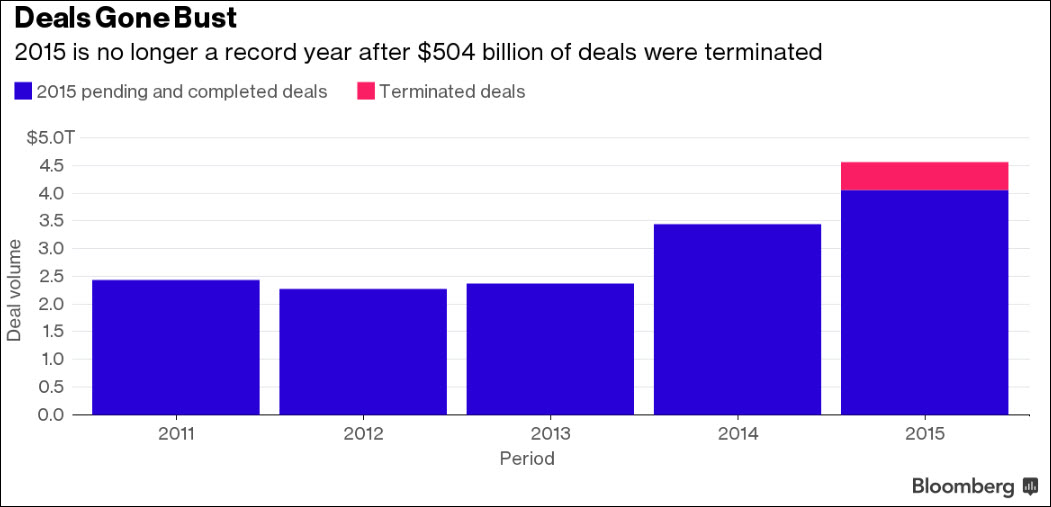
2015 was the year of M&A (Mergers & Acquisitions): some $5 trillion in global merger and acqusition deals were announced, the highest level ever, topping even pre-crash 2007. In fact, last year there were more mega-deals, those valued at $20 billion or above, than ever. In all, there were 17 deals at or above that value compared with 35 such deals in the five years from 2010 through 2014. Such was the cheap debt-fuelled boom in large deals that the average size of all M&A valued at $500 million or above was $3.3 billion, up from $2.2 billion in 2014.
However, as Bloomberg observes, this year M&A is hitting a more dubious record: deals gone bust as some 10%, or $504 billion, of all deals announced last year have been terminated following a furious crackdown by the US Treasury on tax inversions which killed what would have been the biggest M&A deal ever, Pfizer’s acquisition of Allergan, as well as numerous other deals found to have been anti-competitive by the FTC.
Wednesday was especially bad for bankers as two mergers valued at a combined $21 billion collapsed. The latest cancelled deals mean 2015 has been stripped of its title as the biggest year for deal-making, dropping to $4.06 trillion compared with 2007’s $4.09 trillion.

Size isn’t the only factor drawing scrutiny. Antitrust enforcers at the Justice Department in April frustrated Canadian Pacific Railway Ltd.’s bid to buy Norfolk Southern Corp., opposing a voting trust structure that called for Canadian Pacific’s chief executive to run Norfolk Southern.
According to Bloomberg, in many cases the companies and their bankers can blame themselves for some of the failures, said Ira Gorsky, an analyst with Jersey City, New Jersey-based Elevation LLC. Deals have grown so large, and in already consolidated industries, as to provoke the wrath of aggressive antitrust enforcers. “Companies have really pushed the envelope in terms of the size of deals being attempted,” Gorsky said.
That was the case with the end of Staples Inc.’s attempt to buy Office Depot Inc. for $6.3 billion. The FTC had argued that uniting the office suppliers would harm buyers, and a federal judge agreed in a filing Tuesday. The companies said they would terminate their agreement. Hours later, the European Union blocked CK Hutchison Holdings Ltd.’s 10.25 billion pound ($14.8 billion) bid to buy Telefonica SA’s O2 unit. Regulators cited the merger’s potential to hinder competition and drive up prices.
But while company officers – who have given up on major stock upside as a result of busted M&A – and investment bankers are lamenting the bursting of the M&A bubble, some of the biggest losers are on the buyside, where merger arbs have seen billions in paper profits turn into billions in paper losses in moments upon the announcement of deal termination.
Indeed, broken deals have whipsawed hedge funds that focus on merger arbitrage. As the NYT poetically puts it, according to one “arb” the current mood of the industry: “Every day is like showing up unsure of whether to wear a helmet or a diaper.”
“You’re definitely seeing a hangover from the M&A party from 2015,” said Aly El Hamamsy, a partner in Cadwalader, Wickersham & Taft’s mergers-and-acquisitions group, which occasionally advises arbs. “Things will stay interesting for a few months at least.”
To be sure, in the aftermath of the Allergan deal we highlighted “How The U.S. Treasury Just Crushed 80 Hedge Funds“, all who were long one of the most popular names on Wall Street. This was just one example: since then countless other popular merger deals have led to even more widespread pain among merger arbs, all of whom have suffered substantial losses on trades that offered little upside and major downside as those who were involved in the Office Depot/Staples failed merger found out the hard way this week.
Some more perspective on the shockwave that has sent the merger arb community reeling in recent months from the NYT:
Historically, merger arbitrage has been the calm hinterland of the investing world. Traders usually buy up shares in the company that is being acquired; those shares tend to trade slightly below the buyer’s offer price, often by just pennies. Once a deal is done, that gap closes, and arbs will make money on the difference. (Some trades involve hedging through the acquirer’s stock as well.) Such trading has been considered low risk for small returns.
These days, it is a different story. Take this April, for example. It began with Anbang Insurance Group abruptly withdrawing its $14 billion offer for Starwood Hotels and Resorts, ceding it to Marriott International for a lower price. The next bombshell came three days later, when the Treasury Department issued new rules to curb cross-border mergers aimed at lowering an American company’s tax bill, a move that ultimately led to the breakup of Pfizer’s deal with Allergan.
Allergan’s stock dropped 20 percent in overnight trading after the Treasury announced its new rules, according to a letter after the deal collapsed from the hedge fund Ramius to its investors. The letter, which was reviewed by The New York Times, said, “We regret this setback, and ask for your patience as we follow our discipline to attempt to earn back lost value in a prudent fashion.” Ramius was already down 2.91 percent for March before the deal was scuttled, after being up 4.37 percent in February, the letter said.
Some other prominent examples include Halliburton, which had agreed to acquire Baker Hughes in November 2014 for $35 billion. After an excruciatingly long regulatory review process, the Justice Department sued to block the deal in April. The two companies decided to terminate it on May 1. Then earlier this week, on Tuesday Staples and Office Depot called it quits on their own $6.3 billion merger attempt after a federal judge blocked the deal. As was the case in the oil patch, these two retailers were halted from combining because in doing so, they would, in the judge’s words, “substantially impair” competition.
As the NYT correctly writes, the pain did not end there. Shortly after even more mergers seemed doomed, especially because at least two companies have made overtures to kill transactions in cases of buyer’s remorse. Energy Transfer Equity, a Dallas-based pipeline operator that initially had to coax a majority of the Williams Companies board to agree to its $38 billion offer in September, was frantically searching for a way out of the deal by springtime. Things started to look shaky when Williams Companies sued Energy Transfer and its chairman, Kelcy Warren, in mid-April, claiming he had breached the merger agreement. Then Mr. Warren said several times during the company’s earnings conference call last week that the deal “can’t close” because of a complicated tax opinion. Williams firmly believes it can.
Investors overwhelmingly think the deal, as it was agreed on seven months ago, is doomed. Of about 150 fund managers surveyed by Evercore ISI, 84 percent do not expect the deal to close in its current form.
Other troubled deals include drug maker Abbott’s $5.8 billion acquisition of Alere, which makes medical diagnostics tests. At the end of April, less than three months after their deal was announced, Alere put out a statement saying that Abbott was trying to terminate their agreement but that Alere had denied the request.
Luckily for those long Williams and Alere, lawyers say neither Energy Transfer nor Abbott has a clear way out of its deal. Yet the market is treating these situations as if they are practically doomed, a change that can dent arbs’ returns, at least in the short run.
Ironically, as many existing arbs blow up, it opens up an opportunity for a new batch of buysiders to jump in, with hopes that they will get it right.
As the market becomes more skeptical about pending deals, arbitrage traders could make a bigger return on deals that do close. After the Treasury’s new rules, the market became more uncertain about the Irish drug maker Shire’s $31 billion acquisition of Baxalta. Even though the deal is set to close in less than a month, traders that buy in now could receive a decent return.
These broken deals have had a chilling effect on new deals, but they are unlikely to stop the market completely. Lawyers say chief executives and boards are already asking more-detailed questions about potential contracts and will continue to do so. They want to learn from the mistakes of deals gone awry.
“There will be a heightened focus on the negotiated deal terms,” said William J. Curtin, global head of mergers and acquisitions at the law firm Hogan Lovells. “Whether the additional piece is a slowing of transaction activity, I believe it remains to be seen.”
One thing is clear: as long as central banks keep flooding the market with trillions in excess liquidity, there will always be some hedge fund wiling to take a gamble at a “guaranteed” 20% arb return. Unless, of course, LPs and other hedge fund investors finally wake up and realize what we have been saying all along since 2012, namely that in a time when central bankers themselves assure of the highest possible risk-adjusted return (and with central banks now Chief Risk Officers there is virtually no risk of any market crash as long as money can still be printed to prop up risky assets), there is no point in handing over 2 and 20 to someone who will either under-perform the market or crush spectacularly. As such, we would also not be surprised to see the relentless wave of money being pulled from hedge funds continue, one which has culminated in what has been a shocking, and record, 15 consecutive weeks of redemption-driven outflows from “smart money” investors who are suddenly finding themselves scrambling not just to find “dry powder”, but how to cover increasingly more frequent margin calls.
Contact Ulli